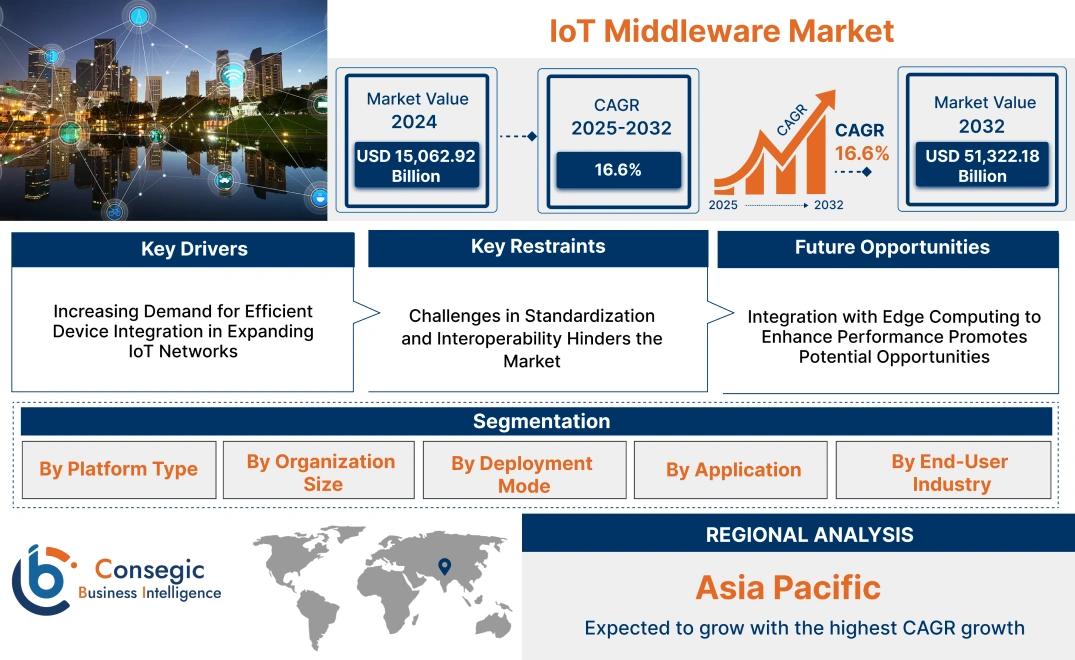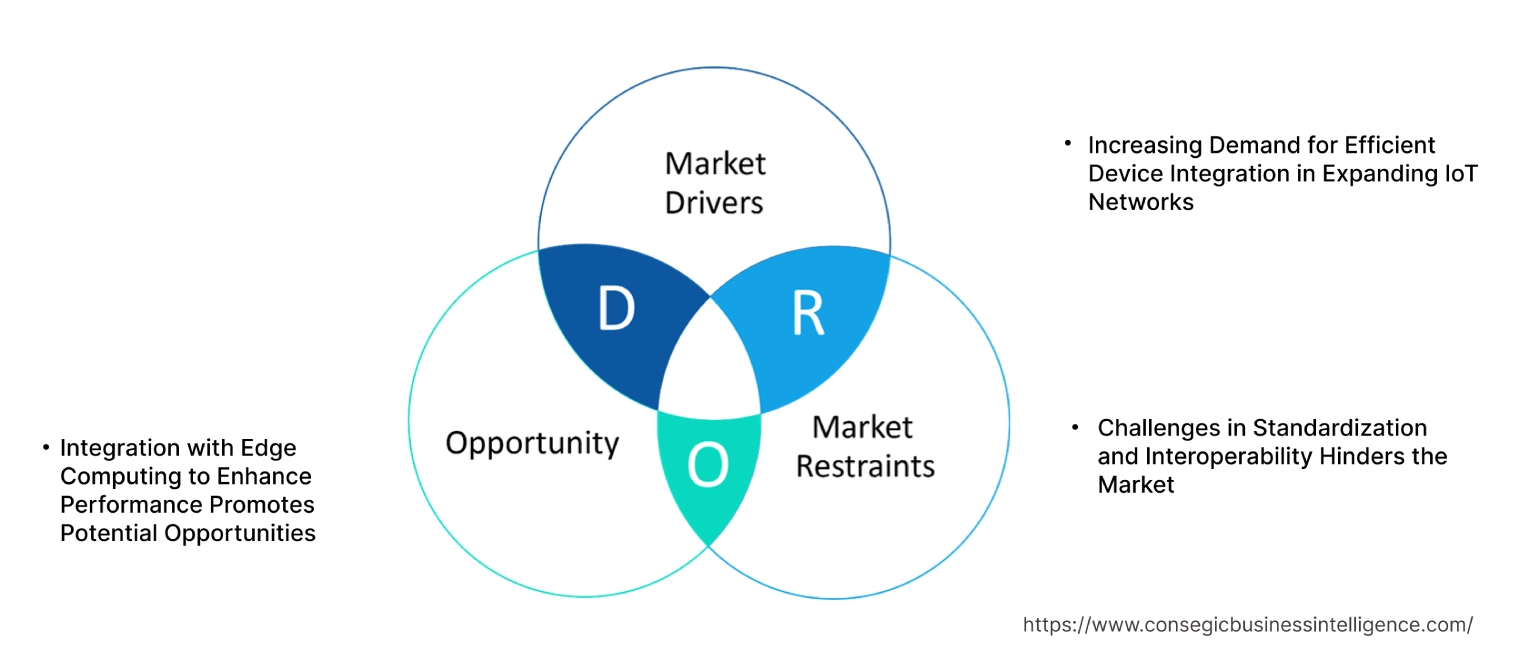IoT Middleware Market Size:
IoT Middleware Market size is estimated to reach over USD 51,322.18 Million by 2032 from a value of USD 15,062.92 Million in 2024 and is projected to grow by USD 17,288.94 Million in 2025, growing at a CAGR of 16.60 % from 2025 to 2032.
IoT Middleware Market Scope & Overview:
The IoT middleware are software solutions that act as intermediaries between hardware and application layers in IoT systems. It enables seamless communication, data management, and integration between various IoT devices and applications. This layer ensures smooth device connectivity, data collection, and the translation of device-generated information into actionable insights. Key benefits include improved device interoperability, enhanced data processing capabilities, and streamlined integration of different IoT ecosystems. These solutions are critical for managing large-scale IoT deployments, ensuring secure and efficient data transmission between devices, and supporting real-time decision-making. It facilitates the development of smart systems by allowing different devices and platforms to work together, ensuring better operational efficiency and automation in these industries. End-use industries benefiting include manufacturing, healthcare, energy, transportation, and retail, as businesses increasingly rely on IoT systems for better connectivity and automation.
IoT Middleware Market Dynamics - (DRO) :
Key Drivers:
Increasing Demand for Efficient Device Integration in Expanding IoT Networks
As IoT ecosystems grow, there is a critical need for seamless integration of diverse devices to ensure smooth communication and data exchange. IoT middleware acts as a bridge between various hardware and software systems, enabling the interaction of devices with different protocols. This is especially important in sectors such as manufacturing, smart cities, and healthcare, where real-time data flow and device coordination are essential for operational efficiency.
Thus, the ability of IoT middleware to simplify complex integrations and provide scalability is a key factor driving the IoT middleware market growth.
Key Restraints :
Challenges in Standardization and Interoperability Hinders the Market
A significant challenge for IoT middleware lies in the lack of standardization among IoT devices and communication protocols. Different manufacturers often use proprietary technologies, which complicates the integration of devices within a unified system. This increases the complexity, cost, and time required to deploy IoT solutions. In sectors like healthcare and defense, where security and real-time performance are crucial, these interoperability issues can lead to inefficiencies and delays.
Thus, the absence of global standards for IoT technology remains a major obstacle to the widespread adoption of middleware solutions, restraining the IoT middleware market demand.
Future Opportunities :
Integration with Edge Computing to Enhance Performance Promotes Potential Opportunities
The growing adoption of edge computing presents a significant opportunity for the market. By processing data closer to the source, edge computing reduces latency and enhances the efficiency of IoT systems. Middleware platforms that are designed to integrate with edge architectures can deliver faster data processing and improved real-time decision-making. This is particularly beneficial in industries such as autonomous vehicles, industrial automation, and healthcare, where real-time data analysis is critical.
Middleware solutions that capitalize on edge computing capabilities are expected to play a vital role in managing decentralized IoT networks, improving performance, and reducing costs associated with cloud-based data processing. This, in turn, creates potential IoT middleware market opportunities.
IoT Middleware Market Segmental Analysis :
By Platform Type:
Based on platform type, the market is segmented into device management, application management, connectivity management, security management, and data management.
The device management segment accounted for the largest revenue share of 31.27% in 2024.
- Device management platforms are essential for ensuring the operational efficiency and security of large-scale IoT networks.
- They provide comprehensive capabilities for the provisioning, monitoring, and updating of connected devices in real time, which is critical for industries with high-volume deployments like manufacturing and logistics.
- Advanced features, such as predictive maintenance and remote diagnostics, enable organizations to minimize downtime and extend the lifespan of their IoT devices.
- The rise of this segment is largely attributed to the increasing demand for automation in sectors such as industrial manufacturing and the ongoing expansion of IoT-enabled infrastructures globally.
- The device management segment leads the market due to its vital role in maintaining the health and functionality of large IoT deployments, driven by automation trends and the need for real-time monitoring, driving the IoT middleware market growth.
The security management segment is anticipated to register the fastest CAGR during the forecast period.
- Security management platforms are indispensable in protecting IoT environments, where vulnerabilities can lead to critical data breaches and operational disruptions.
- These platforms offer robust features such as encryption, device authentication, and real-time threat detection.
- The rise of cyber threats targeting IoT systems—combined with the regulatory push for stricter data protection frameworks, such as the GDPR and the NIST framework—drives the urgent need for advanced security solutions.
- The increasing complexity of IoT ecosystems, particularly with the introduction of 5G networks, is further amplifying the need for stronger, scalable security measures.
- The security management segment is expected to witness the highest growth, as companies prioritize cybersecurity to protect their expanding IoT networks from increasing threats and regulatory pressures, boosting the IoT middleware market trends.
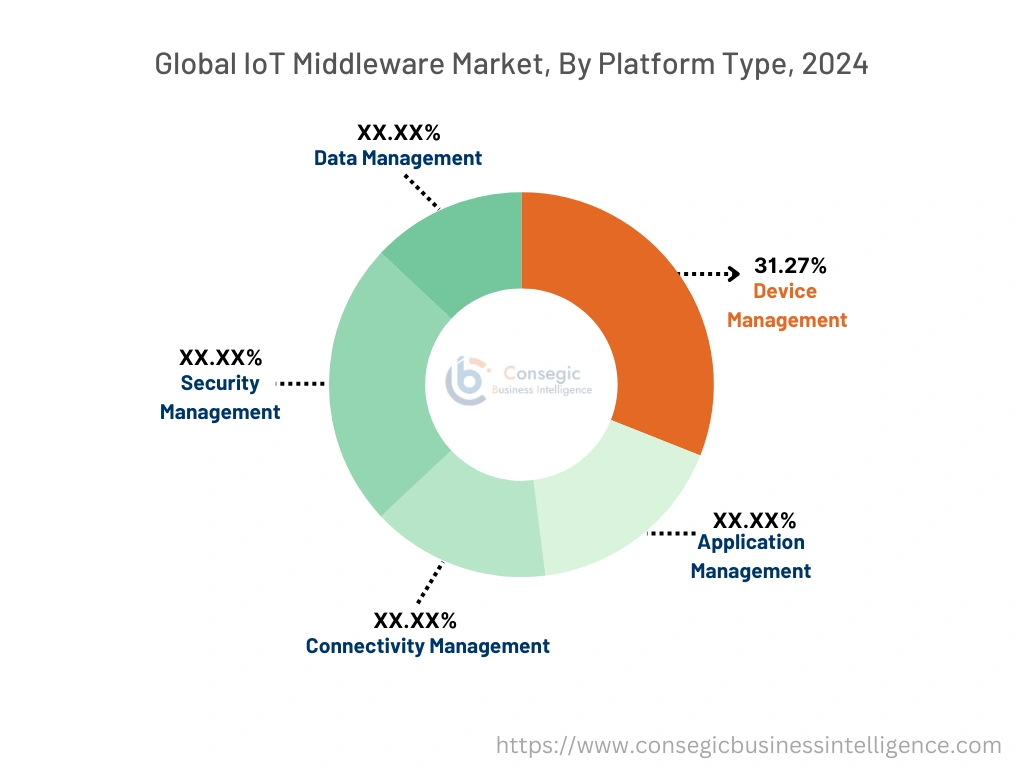
By Organization Size:
Based on organization size, the market is segmented into small & medium enterprises (SMEs) and large enterprises.
The large enterprises segment accounted for the largest revenue of the total IoT middleware market share in 2024.
- Large enterprises dominate the market due to their complex IoT infrastructures that span across multiple geographies and business functions.
- These organizations require middleware solutions to integrate diverse IoT devices with legacy systems, manage data flows, and streamline operations across their global network.
- Industries like automotive, energy, and telecommunications lead the adoption curve, as their reliance on real-time data and operational efficiency demands robust middleware platforms.
- Enterprises also leverage middleware for advanced data analytics and AI-driven insights to gain competitive advantages.
- The large enterprises segment continues to lead the market, driven by the need for sophisticated middleware solutions to manage large-scale IoT ecosystems and enable data-driven operations across global networks, boosting the IoT middleware market demand.
The small & medium enterprises (SMEs) segment is anticipated to register the fastest CAGR during the forecast period.
- SMEs are increasingly adopting IoT middleware due to the availability of affordable, cloud-based platforms that provide flexibility and scalability.
- With IoT applications becoming more accessible, SMEs can leverage middleware to enhance operational efficiency, monitor assets remotely, and improve service delivery.
- Sectors such as retail, agriculture, and logistics are at the forefront of this trend, utilizing middleware to automate processes and gain real-time insights into business operations without the need for heavy infrastructure investment.
- The SME segment is poised for rapid surge as IoT solutions become more affordable and essential for improving operational efficiency in competitive industries like retail and logistics, propelling the IoT middleware market trends.
By Deployment Mode:
Based on deployment mode, the market is segmented into on-premise and cloud-based.
The cloud-based segment accounted for the largest revenue of the total IoT middleware market share in 2024.
- Cloud-based middleware is favored by organizations due to its flexibility, cost-efficiency, and ability to scale in line with IoT infrastructure development.
- Cloud platforms facilitate seamless integration with IoT devices and third-party applications, enabling businesses to streamline data collection, analysis, and storage.
- The increasing adoption of cloud solutions by industries such as retail, healthcare, and manufacturing has accelerated this segment's dominance.
- Moreover, cloud-based middleware supports AI and machine learning integrations, allowing organizations to implement advanced predictive analytics and automation.
- Thus, analysis of segmental trends shows that cloud-based middleware leads the market due to its scalability, lower operational costs, and ability to support AI-driven analytics, making it an ideal solution for organizations expanding their IoT ecosystems, driving the IoT middleware market expansion.
The on-premise segment is anticipated to register the fastest CAGR during the forecast period.
- On-premise middleware solutions remain essential for industries where data security and compliance are critical, such as banking, healthcare, and government.
- These solutions provide greater control over data and system configurations, ensuring compliance with strict regulatory requirements.
- On-premise deployment is particularly important for organizations managing sensitive information or operating in regions with limited cloud infrastructure availability.
- While cloud solutions dominate, the need for localized data management and security keeps on-premise solutions relevant.
- Thus, as per the segmental trends analysis, the On-premise deployment remains critical in highly regulated industries that require stringent control over data privacy and system configurations, particularly in sectors like finance and healthcare, boosting the IoT middleware market opportunities.
By Application:
Based on application, the market is segmented into smart manufacturing, smart transportation, smart healthcare, smart retail, smart grid, connected logistics, and others.
The smart manufacturing segment accounted for the largest revenue share in 2024.
- Smart manufacturing is at the forefront of IoT adoption, leveraging middleware for real-time monitoring, automation, and predictive maintenance.
- IoT middleware enables the seamless integration of sensors, machines, and enterprise systems, allowing manufacturers to optimize production lines, reduce waste, and prevent equipment failures.
- The demand for Industry 4.0 solutions is a major driver of the segment, as manufacturers look to automate operations and enhance operational efficiency through data-driven insights.
- Smart manufacturing leads the market as IoT middleware plays a crucial role in enabling advanced automation and real-time monitoring in production environments, driving operational efficiency and cost savings.
The smart healthcare segment is anticipated to register the fastest CAGR during the forecast period.
- IoT middleware in healthcare supports critical applications such as remote patient monitoring, telemedicine, and the management of connected medical devices.
- It ensures secure data transmission and integration with hospital information systems (HIS), enabling healthcare providers to offer personalized and real-time care.
- The rise in chronic diseases and aging populations globally is pushing demand for connected healthcare solutions, making IoT middleware indispensable in managing large volumes of healthcare data securely and efficiently.
- Thus, the IoT middleware market analysis shows that smart healthcare is expected to grow rapidly as IoT middleware becomes essential for improving patient care, supporting telemedicine, and managing connected medical devices in a secure and scalable manner.
By End-User Industry:
Based on end-user industry, the market is segmented into manufacturing, healthcare, retail, transportation & logistics, energy & utilities, banking & financial services, government, and others.
The manufacturing segment accounted for the largest revenue share in 2024.
- The manufacturing sector remains the largest adopter of IoT middleware, utilizing it for optimizing production processes, reducing downtime, and enabling predictive maintenance.
- Middleware is crucial for integrating legacy systems with modern IoT solutions, ensuring seamless communication between machines and centralized systems.
- By using IoT middleware, manufacturers can gain real-time insights into their operations, enhance supply chain management, and implement automation across the factory floor, all of which are critical for staying competitive in global markets.
- Thus, the segmental trends analysis shows that the manufacturing continues to dominate the market due to its reliance on real-time data, predictive maintenance, and the need for integrating legacy systems with modern IoT solutions.
The healthcare segment is anticipated to register the fastest CAGR during the forecast period.
- Healthcare providers are rapidly adopting IoT middleware to integrate connected medical devices, enable remote monitoring, and streamline hospital operations.
- Middleware ensures the secure exchange of patient data, facilitates real-time diagnostics, and supports regulatory compliance in highly sensitive healthcare environments.
- The ongoing digital transformation in healthcare, coupled with the rising demand for telemedicine and connected medical devices, positions the healthcare segment for significant rise.
- Thus, as per the IoT middleware market analysis, the healthcare sector is poised for the fastest growth, driven by the rising adoption of IoT-enabled medical devices, telemedicine platforms, and the need for secure, real-time data management in healthcare settings.
Regional Analysis:
The regions covered are North America, Europe, Asia Pacific, the Middle East and Africa, and Latin America.
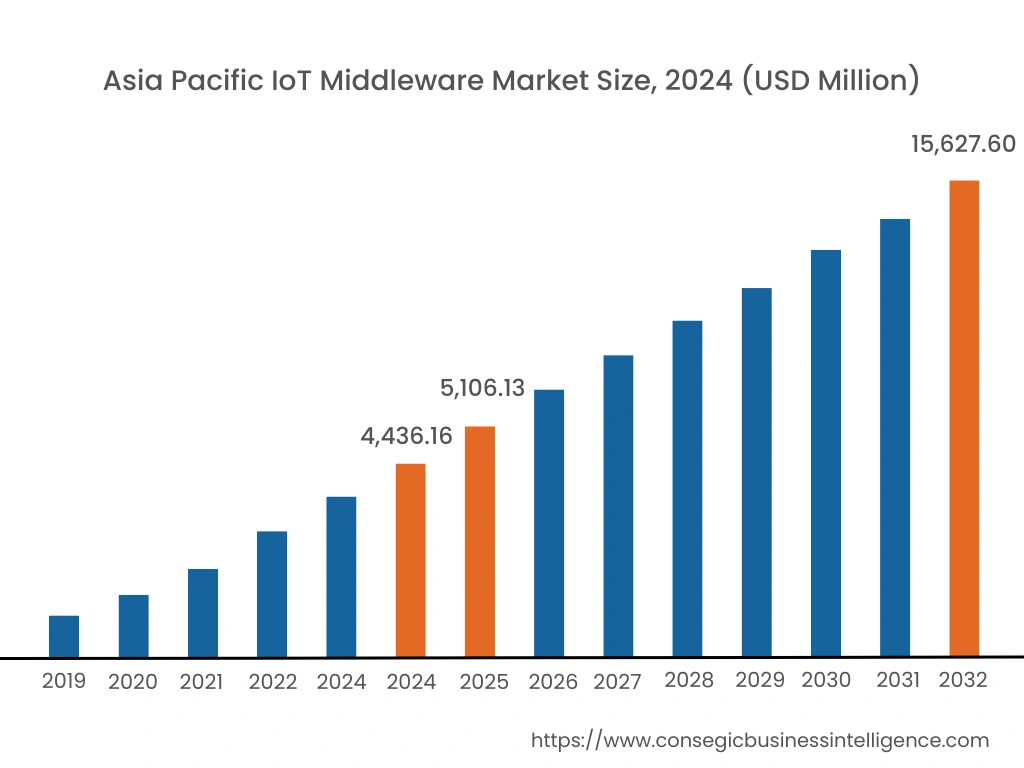
Asia Pacific region was valued at USD 4,436.16 Million in 2024. Moreover, it is projected to grow by USD 5,106.13 Million in 2025 and reach over USD 15,627.60 Million by 2032. Out of this, China accounted for the maximum revenue share of 33.2%. Asia-Pacific is driven by rapid industrialization, smart city initiatives, and large-scale IoT deployments in countries like China, Japan, and South Korea. China's emphasis on smart manufacturing under its Made in China 2025 initiative and extensive IoT infrastructure development is boosting demand for middleware platforms. Japan's advanced automotive sector and South Korea's focus on 5G-enabled IoT solutions further accelerate growth. However, challenges such as the lack of standardized IoT frameworks and interoperability issues across various devices and platforms hinder IoT middleware market expansion.
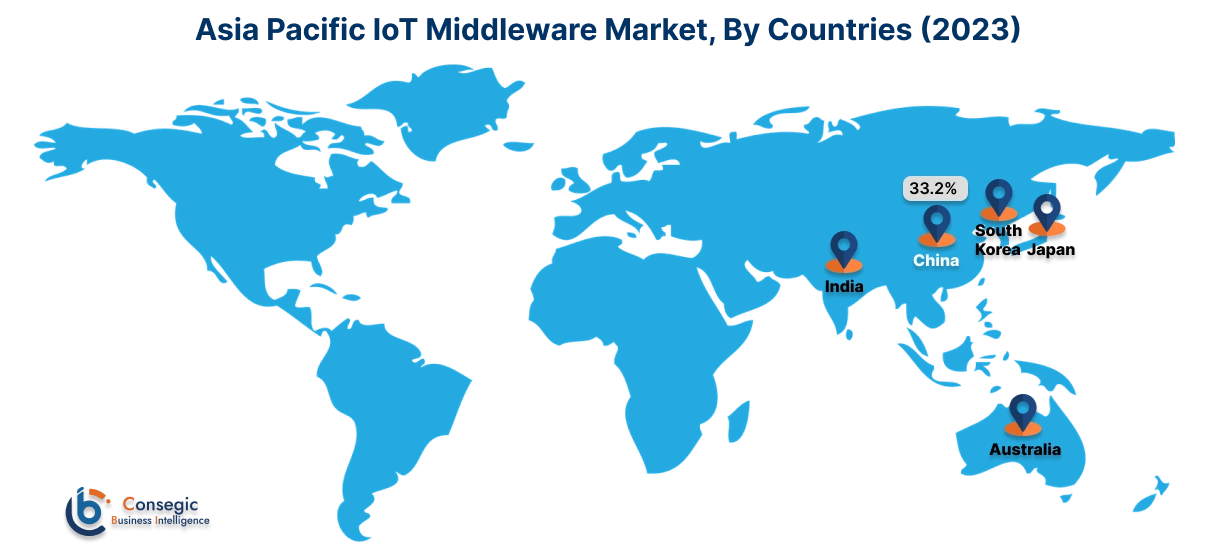
North America is estimated to reach over USD 16,633.52 Million by 2032 from a value of USD 4,996.50 Million in 2024 and is projected to grow by USD 5,723.92 Million in 2025. The U.S. leads due to the rapid adoption of IoT technologies across industries such as manufacturing, healthcare, and smart cities. Major players like Microsoft, IBM, and PTC dominate the landscape, providing middleware platforms that enable seamless device connectivity and data management. Strong investments in IoT infrastructure, driven by sectors like automotive and energy, also fuel the market. However, challenges such as fragmented IoT ecosystems and concerns over data privacy impact market scalability.
Europe is the second-largest market, driven by a strong focus on Industry 4.0 initiatives and government policies supporting digital transformation. Countries like Germany, the UK, and France lead in IoT adoption across industries, especially in smart manufacturing and connected healthcare. The European Union's General Data Protection Regulation (GDPR) has pushed companies to prioritize secure and compliant middleware solutions. Germany's strong manufacturing base and focus on industrial IoT (IIoT) drive middleware demand, though complex regulatory environments and integration challenges pose obstacles to market.
The regional trends analysis The Middle East and Africa are witnessing moderate growth in the market, primarily driven by smart city projects and industrial IoT initiatives in the UAE, Saudi Arabia, and South Africa. The UAE's focus on smart infrastructure, especially in sectors like transportation and utilities, has increased demand. Saudi Arabia's Vision 2030 initiative and its push for digital transformation across industries also contribute to market expansion. However, limited access to advanced technologies and a lack of IoT expertise in some parts of the region are key barriers.
Latin America is an emerging market, with countries like Brazil and Mexico leading the way. The region's growth is driven by increasing IoT deployments in smart agriculture, logistics, and energy management. Brazil's focus on IoT for agriculture and Mexico's growing use of IoT in manufacturing are key factors contributing to the market's expansion. However, economic instability and infrastructure limitations in certain countries slow the adoption of advanced IoT solutions, creating challenges for widespread deployment of middleware platforms.
Top Key Players & Market Share Insights:
The IoT middleware market is highly competitive with major players providing products and services to the national and international markets. Key players are adopting several strategies in research and development (R&D), product innovation, and end-user launches to hold a strong position in the global IoT middleware market. Key players in the IoT middleware industry include-
- IBM Corporation (USA)
- Microsoft Corporation (USA)
- SAP SE (Germany)
- Amazon Web Services (AWS) (USA)
- Oracle Corporation (USA)
- Cisco Systems, Inc. (USA)
- Google LLC (USA)
- PTC Inc. (USA)
- Bosch Software Innovations GmbH (Germany)
- Fujitsu Ltd. (Japan)
Recent Industry Developments :
Product Launches:
- In June 2024, Asteria Corporation and Tapway have formed a strategic alliance to co-develop an Edge AI and IoT solution using no-code technology, aiming to expand their presence in Southeast Asia and Japan. Tapway, known for its Vision AI technology, will provide Asteria access to the SEA market, while Asteria's no-code platforms, such as Gravio, will enable Tapway to enter the Japanese market, driving innovation across industries like transportation, retail, and smart cities.
- In March 2023, Alliot Technologies launched Symbius, an IoT middleware platform designed to simplify cellular IoT by converting data from various devices into a common format, removing the need for manual protocol adjustments. This launch strengthens Alliot's position as a leading cellular IoT provider, complementing their NB-IoT and LTE-M solutions in partnership with Vodafone.
IoT Middleware Market Report Insights :
| Report Attributes | Report Details |
| Study Timeline | 2019-2032 |
| Market Size in 2032 | USD 51,322.18 Million |
| CAGR (2025-2032) | 16.6% |
| By Platform Type |
|
| By Organization Size |
|
| By Deployment Mode |
|
| By Application |
|
| By End-User Industry |
|
| By Region |
|
| Key Players |
|
| North America | U.S. Canada Mexico |
| Europe | U.K. Germany France Spain Italy Russia Benelux Rest of Europe |
| APAC | China South Korea Japan India Australia ASEAN Rest of Asia-Pacific |
| Middle East and Africa | GCC Turkey South Africa Rest of MEA |
| LATAM | Brazil Argentina Chile Rest of LATAM |
| Report Coverage |
|
Key Questions Answered in the Report
How big is the IoT Middleware Market? +
IoT Middleware Market size is estimated to reach over USD 51,322.18 Million by 2032 from a value of USD 15,062.92 Million in 2024 and is projected to grow by USD 17,288.94 Million in 2025, growing at a CAGR of 16.60 % from 2025 to 2032.
Which is the fastest-growing region in the IoT Middleware Market? +
The Asia Pacific region is projected to be the fastest-growing region in the IoT Middleware Market. This is due to the rapid industrialization, growing investments in IoT technologies, and the increasing number of smart city initiatives in countries like China, India, and Japan.
What specific segmentation details are covered in the IoT Middleware report? +
The IoT Middleware Market report covers segmentation by platform type, deployment mode, organization size, application and end-use industry.
How is the dominating segment impacting the market growth? +
The Cloud-based Deployment Mode segment is dominating the IoT Middleware Market due to its scalability, flexibility, and cost-efficiency. This segment's dominance is facilitating faster adoption of IoT middleware solutions, particularly among SMEs, driving overall market growth.
